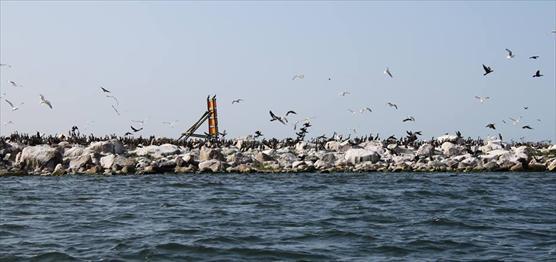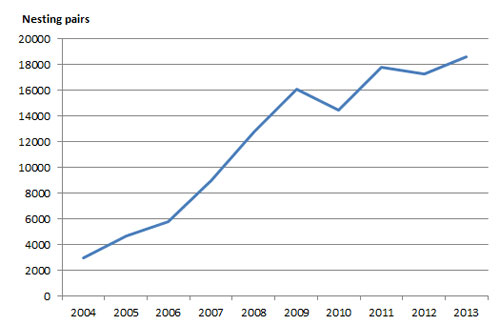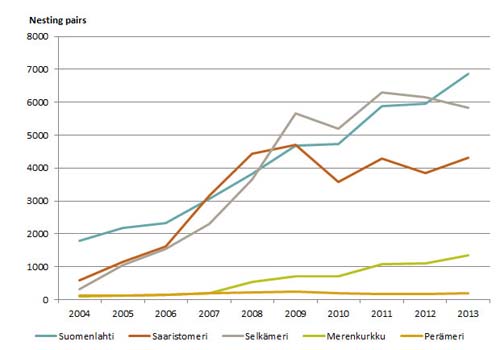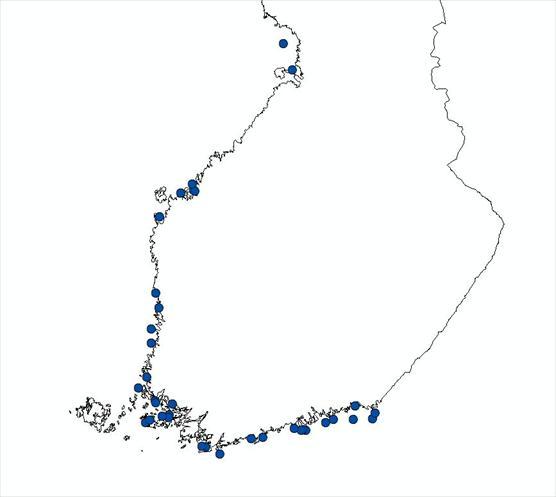Press release 2013-07-31 at 15:44
A total of 18,580 cormorant nests were counted in the Finnish sea areas during summer 2013, eight per cent more than the year before. In contrast to other sea areas, the breeding population in the Bothnian Sea fell by five per cent. Locally some cormorant colonies, for example the one in Pargas, grew smaller due to predation by white-tailed eagles.

A cormorant colony. Photo: Seppo Knuuttila.
The first cormorant nests in Finland were observed in 1996 in the Gulf of Finland. Population growth was slow at first, but gained speed after the turn of the millennium following immigration from the Southern Baltic Sea. In 2003–2007, annual population growth averaged 47 per cent, but only 16 per cent in 2008–2012. Throughout its history the Finnish breeding population has fallen twice, in 2010 and 2012.

Total number of cormorant nests in 2004–2013.
Most cormorants in the Gulf of Finland and the Bothnian Sea
The breeding population was strongest in the Gulf of Finland (6,873 nests) and the Bothnian Sea (5,840 nests), while 4,318 nests were counted in the Archipelago Sea, 1,358 in Kvarken and 193 in the Bay of Bothnia.
About half of cormorant colonies grew while the rest diminished from the previous summer or retained their size. Two new cormorant colonies were discovered in Finnish sea areas, located at Porvoo and Malax.
The largest increase in the number of nests was discovered in the Gulf of Finland, a total of more than 900 new nests. The growth focused on four colonies in Virolahti, Porvoo, and Kirkkonummi. The number of new nests in the Archipelago Sea was slightly less than 500, the largest growth taking place in a colony in Uusikaupunki. In the Bothnian Sea, the number of nests decreased in Rauma and Pori but increased in Luvia and Merikarvia. The colony in Merikarvia colony contained 2,650 nests, making it the largest in Finland.
A total of 36 cormorant colonies were found in the Finnish sea area, nesting on 62 islets or islands. One fifth of the cormorants nested in trees. Two thirds of the nests were located in nature conservation areas.

Cormorant nest numbers by sea area in 2004–2013.
White-tailed eagles have local impacts
White-tailed eagles were observed in the cormorant colonies of Loviisa, Pargas, Kustavi, Luvia and Pori. The colony most predated by white-tailed eagles, in Pargas grew smaller for the second summer in succession, having lost nearly 500 nests compared to the previous year. Up to ten eagles at a time were spotted hunting in the colony.
A colony of nearly a hundred nests in Kustavi stopped nesting altogether because of the continuous presence of and disturbance from white-tailed eagles. In Pori, the number of nests dropped by 50 per cent, to less than 800 nests. Up to six white-tailed eagles were seen in the proximity of the colony.
Human-induced destruction of cormorant nests and killing of chicks has decreased in recent years. Cormorant nests were illegally destroyed in at least two colonies: in Korsholm (73 nests) and Malax (59 nests).

Cormorant nesting colonies in summer 2013.
For further information, please contact:
Pekka Rusanen, Researcher, Finnish Environment Institute SYKE,
tel. +358 400 148 691, firstname.lastname@ymparisto.fi
Markku Mikkola-Roos, Senior Researcher, Finnish Environment Institute SYKE,
tel. +358 400 148 685, firstname.lastname@ymparisto.fi
Riku Lumiaro, Communications Specialist, Finnish Environment Institute SYKE,
tel. +358 40 5098 654, firstname.lastname@ymparisto.fi